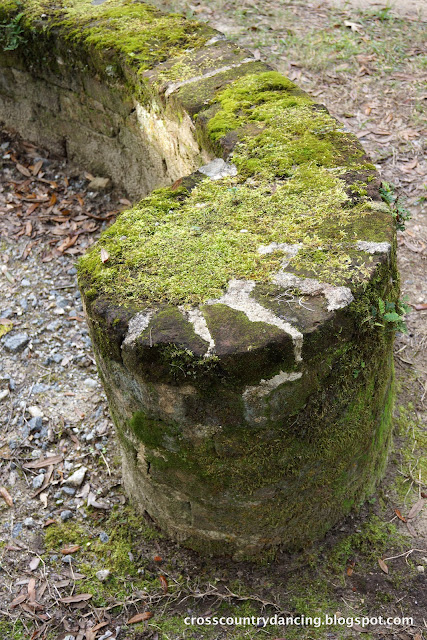This December we've returned to Mount Pleasant, SC to visit with family for the holidays. We're staying at the
KOA, which has made some improvements since we stayed two years ago, most importanly (to us) a new dog park. Although we've done lots of sightseeing in Mount Pleasant/Charleston in previous years, we never got to
Boone Hall Plantation, one of the most popular historic destinations in the area.
 |
| The 88 live oak lined entrance to Boone Hall |
The admission fee to Boone Hall covers a guided house tour, tram tour, self-guided walking tour of grounds, gardens, cotton dock and slave quarters, butterfly garden and access to the Butterfly Cafe. It easily takes at least half a day.
As we drove down the 88 tree, 3/4 mile live oak lined entrance road, we stopped to take a picture and noted that we were standing on an old brick bridge over an unusually deep canal. Later we learned that the canal was dug during the Civil War as an effort to detain the advance of Union troops into Charleston. We also learned that the bricks had been made right at Boone Hall Plantation brickyard.
If you love history, you'll love visiting Boone Hall. Originally a British land grant to John Boone in 1681, it has been a working plantation ever since! It's ownership has changed many times, from John Boone, to a Russian prince, to the current McRae family and others.
 |
| The plantation house and serpentine wall |
Its source of income has also changed many times: from rice, cotton, bricks and pecans to peaches, vegetables, tourism and special events. No cotton any more due to the infestation of the boll weevil along the coast.
As we waited for the noon house tour we walked through the gardens, which were being changed over to their winter annuals.
However, beautiful pink and white camellia bushes, unique to these semi-tropical climes, were blooming along the garden paths.
We had just enough time to wander along the creek and visit the smokehouse. At 250 years, the smokehouse is one of the oldest structures on the plantation.
 |
| Praise house and serpentine wall |
After walking along the serpentine wall (invented by Thomas Jefferson) we headed back to the big house for the tour.
Our tour guide was entertaining and informative as she took us through the downstairs of the period antique furnished house, where no pictures were allowed. They were in the process of decorating for Christmas with hundreds of poinsettias and a couple of trees in every room, each one decorated uniquely. One was decorated completely with cotton balls right off the bush (surprisingly effective) and another with woven sweet grass ornaments. This house is not the original Boone home; it is actually the fourth building on the site, the others having been lost to fire and or torn down for this new structure by Thomas Stone in the early 20th century designed after the traditional southern plantation style.
After the tour we made our way back to the row of brick slave cabins along the oak avenue. Typically the slave houses are placed in back where visiting guests wouldn't see them, but historians guess that this land was the only acreage on the plantation that was not farmable because it flooded regularly with salt water. So they built the slave cabins there.
Each of about eight cabins has a display inside with either an audio or visual recording explaining the display. The first house was described as the "praise house" where slaves were allowed to worship separately from their white owners and overseers. Music, audio description, mannequins and informative plaques explained the history of worship tradition among the slaves, as well as notable spiritual leaders of the time. Other cabins housed displays about dimensions of slave life, emancipation, archeology, agriculture, etc.
Sweet grass baskets are still a highly prized traditional craft of the local Gullah people and are sold along Rt. 17 in Mount Pleasant. Here too a local artisan sells her baskets and explains about the art form.
 |
| Sweet grass basket detail |
A local historian was available to answer questions and expound on topics of his choosing outside one of the cabins.
These houses are not in their original condition, as they were destroyed by Hurricane Hugo in 1989. They are constructed of the same bricks, which were made in the plantation brickyard. The tile roofs replaced the original wood.
Another building on the plantation that was seriously damaged by Hurricane Hugo is the cotton gin. As most readers will know, the cotton gin (short for engine) revolutionized cotton production by providing a fast and efficient method of processing the cotton after picking. The large buildings that house the gin are also called gins. There are still many modern gins in operation throughout the south. This gin had been used as a gift shop and restaurant until the hurricane almost destroyed it. Now it is braced and waiting for a planned multi-million dollar renovation.
We finished our visit with a chilly open air tram tour around agricultural fields of the plantation. Our guide told us more about the history and current use of the plantation. We drove through peach orchards and strawberry fields (that will be ripe in two weeks!). Produce from the farm is sold locally to agricultural cooperatives.
As Christmas approaches our family activities intensify. We'll be visiting, dining out, shopping, having meals at one another's homes, baking cookings, and dancing. There's a nice contradance in North Charleston and one of our nieces is an avid ballroom dancer. We've promised to attend her dance if she'll attend ours, so we anticipate even more dancing and holiday fun.























































